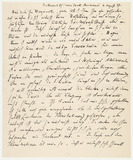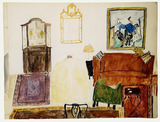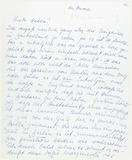Max Beckmann: Familienbild Lütjens [Portrait of the Family Lütjens], painting (1944)
Max Beckmann: Familienbild Lütjens [Portrait of the Family Lütjens], painting (1944)
Lütjens war da und kaufte Familienbild, - der erste Verkauf seit bald vier Monaten.
[Lütjens was here and bought the family portrait – the first sale in almost four months. (ed. trans.)]
Max Beckmann in his journal on 20 December 1944
Hamburg art dealer Helmuth Lütjens, who headed the Amsterdam branch of the Cassirer company, and his wife Nelly were among Beckmann's few close acquaintances in his Dutch exile. He occasionally bought works by the artist, secured others in dangerous phases of the War and even temporarily provided lodgings to the Beckmanns towards the end of the War. The painter, therefore, was bound to Lütjen in gratitude.
The family portrait, which, in addition to Nelly and Helmuth Lütjens also depicts their small daughter Annemarie, was painted without a commission after numerous sketches of the individual subjects.
Beckmann shows the family close together in the evening. Outside darkness reigns, but the room is illuminated by a candle. The small girl points to the jumping-jack in her hand and thus forms a colourfully harmless area while the big adults, echoing the darkness of their clothes in their posture, facial expressions and gestures, make a very earnest impression. Their arms, held before their bodies, seem paused in a movement; the concerned countenance betrays a taut attention which the man is apparently directing towards the darkness outside.
The appearance of the people with regard to the menacing darkness must be understood generally in view of the situation. The War had long since turned to the detriment of the Germans, who also occupied the Netherlands. This heightened the tension between the population and the occupiers; there were repeated attacks on both sides, which in turn fed a wary tension that Beckmann displayed in his portrait of the Lütjens family. The large candle is not explained by a lack of electricity (though that did occur), but is, as in the paintings Les Artistes mit Gemüse, Bildnis Curt Valentin and Hanns Swarzenski and numerous other works by Beckmann, a symbol of life and the human spirit.
Further reading:
‚Come on, now buy a Beckmann too!‘ Portrait of the Lütjens Family in Museum Boijmans Van Beuningen. Rotterdam: Museum Boijmans van Beuningen 2010
Lenz, Christian: Schön und schrecklich wie das Leben. Die Kunst Max Beckmanns 1937 bis 1945. In: Max Beckmann. Exil in Amsterdam. Ausstellungskatalog. Amsterdam / München: Hatje Canz 2007/2008, S. 33-107







